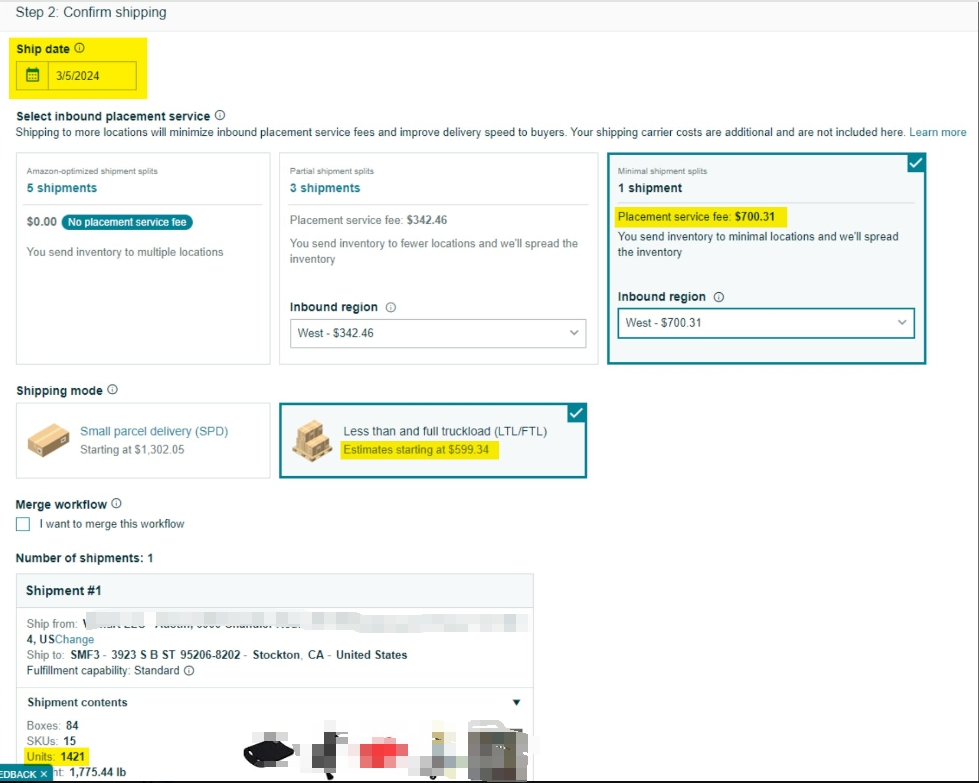NEWS
Understanding Amazon's New Inbound Placement Fee Policy: Implications for Sellers
Release time:2024-03-05 17:56
Last year, Amazon announced that starting from March 1st, the Amazon US site would officially begin charging inbound placement Service fees.
Today marks the fourth day since the new regulations came into effect. It's reported that many sellers, upon creating shipments, have complained upon seeing the backend display of inbound placement fees: "Amazon's policy is too detrimental. Once again, they're shifting the costs onto us sellers, slowly squeezing us dry."
What’s the New Inbound Placement Fee ?
split the products into 3 shipments
split the products into 2- 3 shipments
FBA ship in just one
Amazon-optimized shipment splits 5 shipments ---No placement service fee
2-3 shipments ----placement service fee
1shipment ----higher placement service fee
Sellers Don't Want All-US Warehouses?
Previously, sellers favored the US-West warehouse to save on inbound shipping costs, causing frequent overcrowding and resulting in Amazon spending considerable time redistributing stock evenly. Amazon suggests that sellers follow the system's recommended inventory location and quantity. If sellers can't fully comply, or if their inventory levels are insufficient, or the location can't meet Amazon's distribution requirements, Amazon is willing to redistribute the inventory on behalf of the seller, but at the cost of this inbound placement fee. There are mainly two different inbound placement options:
Single Warehouse Entry:
Sellers can choose to ship inventory to a single receiving or operating center, and Amazon will distribute the inventory within its delivery network on behalf of the seller. Sellers need to pay a certain fee, which may vary depending on the distance to the entry location.
Distributed Warehouse Entry:
Sellers can transport inventory to multiple entry locations themselves, at lower or even no cost. Discounts also depend on various factors such as the quantity of items and entry locations.
Now, Amazon no longer wants to redistribute goods across long distances from popular US-West warehouses, instead opting for random US-wide warehouse allocation, letting sellers deliver to suitable warehouses, and then conducting short-distance redistribution.
Of course, most sellers don't want all-US warehouses? Then they have no choice but to pay! One seller shared the difference between distributed and non-distributed warehousing:

Amazon Optimizes Parcel Splitting: Distributed 4 5 6 7 ... free warehouses, but: warehouses are randomly located across the US, and the number of boxes is random.
Some Parcel Splitting: Splitting inventory into 2-3 warehouses is less expensive. The Amazon revenue calculator says that even with 2-3 warehouses, you can choose between US-East and US-West, but currently, there is no option for US-West. Currently, the number of boxes is random, and the warehouses are randomly located across the US.
Sellers: AGL Comes Into Play
If you don't want all-US warehouse allocation, the fees charged are also very high.
Minimum Parcel Split: One warehouse incurs very high fees, with US-West being the most expensive, followed by US-East. Testing has shown that even if you send one box of goods without splitting the warehouse, you still have to pay fees.
Currently, to avoid inbound placement fees, the number of split warehouses needs to be more than four.
Although you can avoid inbound placement fees, inbound shipping costs have risen. Some sellers claim that AGL can waive this fee. One seller said, "The inbound placement fee is euphemistically called 'small amount and frequent distribution,' optimizing inventory management and improving operational efficiency. In simple terms, it's Amazon shifting the cost of regional redistribution onto sellers, while promoting AGL."
Amazon's official explanation of AGL helps sellers lock products of similar sizes and specifications in the same Amazon operating center, reducing additional costs due to distributed warehousing, improving entry efficiency, and shortening logistics time.
However, it's well known that AGL fees are high. Additionally, some sellers claim that using AGL doesn't necessarily exempt them from inbound placement fees; they need to use Amazon Global Logistics (AGL) for AMP shipping.
Moreover, many sellers also complain about the chaos and excessive splitting of warehouses under the new regulations:
"Wow, I used Amazon's optimized parcel splitting, and out of 300 items across 86 boxes, they split them into 10 parcels. Absolutely speechless."
"Even though it's free, splitting three products into four warehouses is still troublesome. Wanting to split into the same warehouse requires a fee."
"Okay, okay, split into five parcels, I only have a few boxes of goods... ..."
In the initial stages of implementing the new policy, some sellers comforted each other: "Stay calm, everyone, and keep a positive outlook. We're all in this together, equality for all."

 Free Quote
Free Quote





